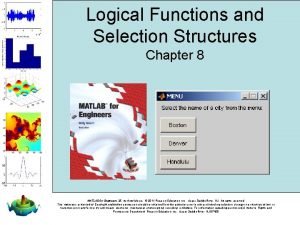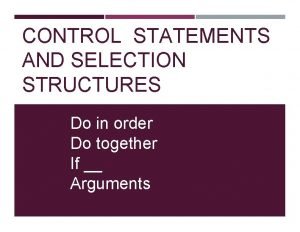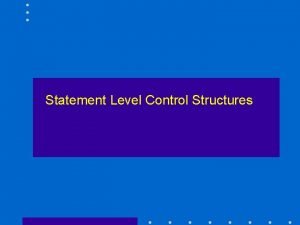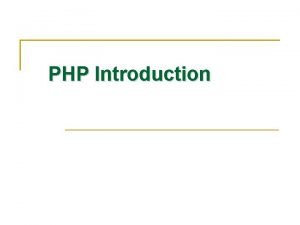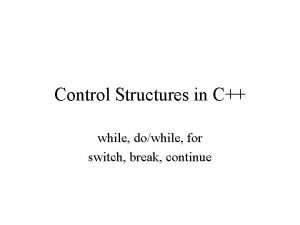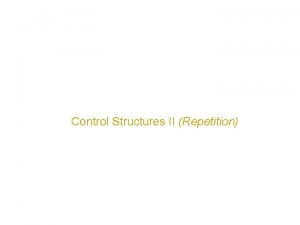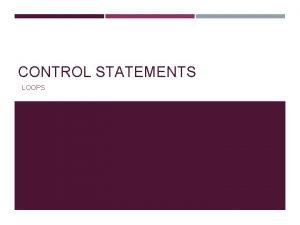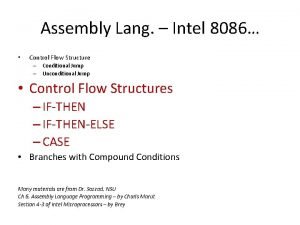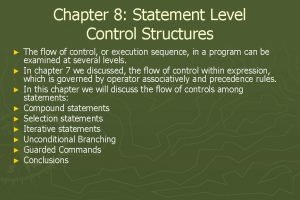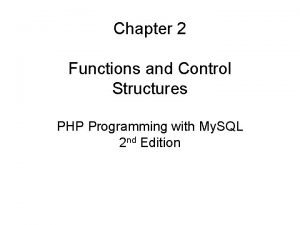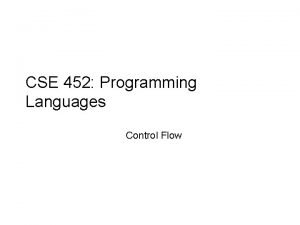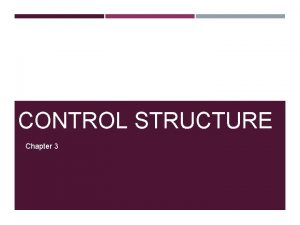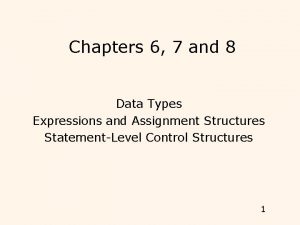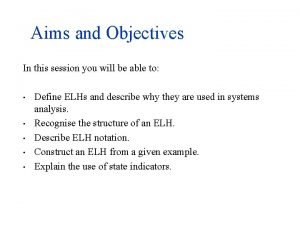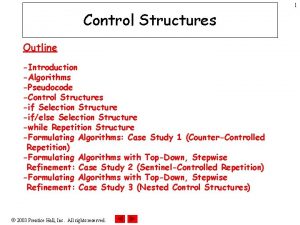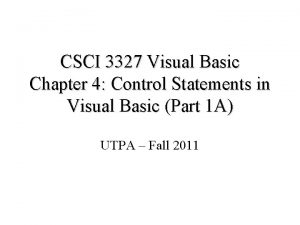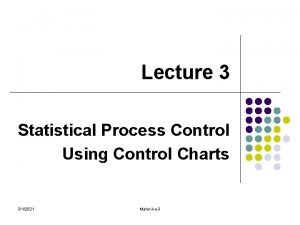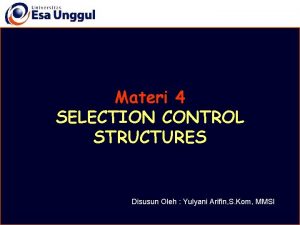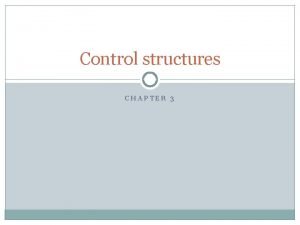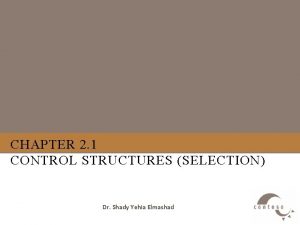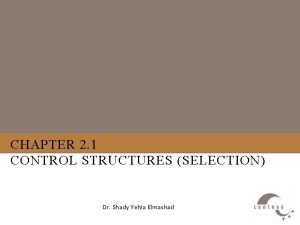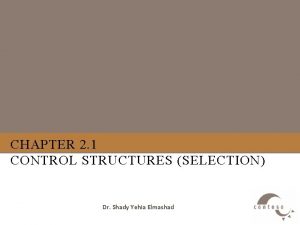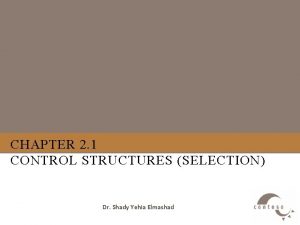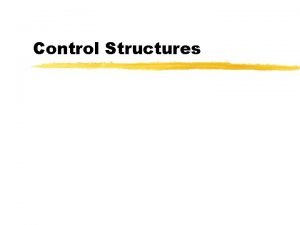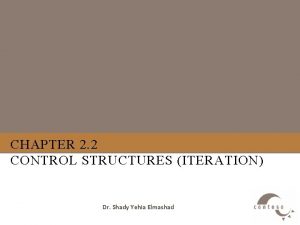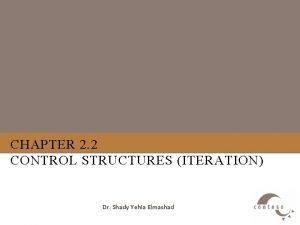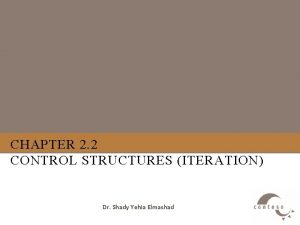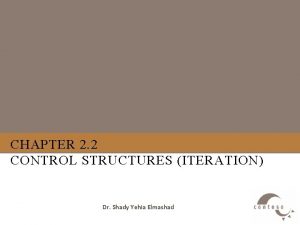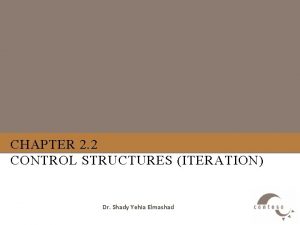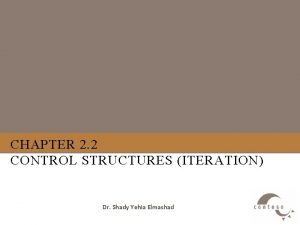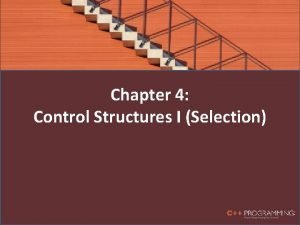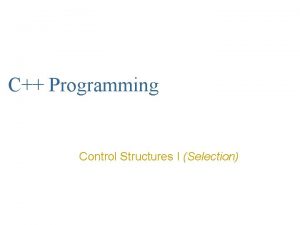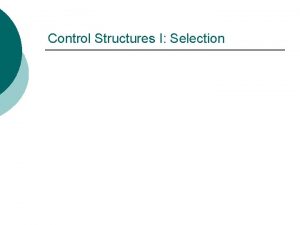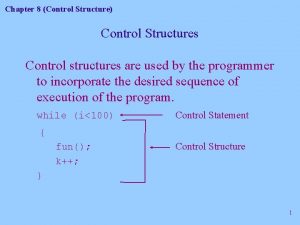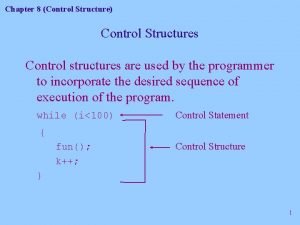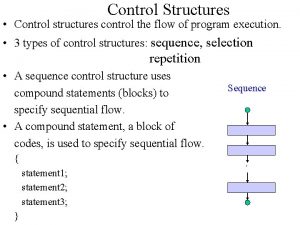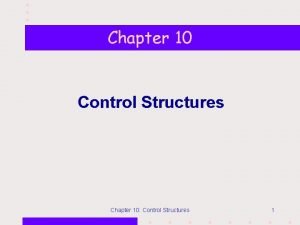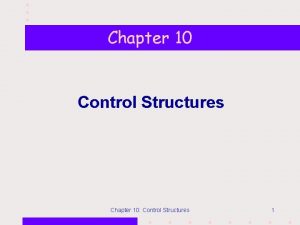CHAPTER 2 1 CONTROL STRUCTURES SELECTION Dr Shady


































- Slides: 34

CHAPTER 2. 1 CONTROL STRUCTURES (SELECTION) Dr. Shady Yehia Elmashad

Outline 1. Introduction 2. Algorithms 3. Pseudocode 4. Control Structures 5. The if Selection Structure 6. The if/else Selection Structure 7. The switch Multiple-Selection Structure

1. Introduction • Before writing a program: - Have a thorough understanding of problem - Carefully plan your approach for solving it • While writing a program: - Know what “building blocks” are available - Use good programming principles

2. Algorithms • All computing problems Ø can be solved by executing a series of actions in a specific order • Algorithm Ø A procedure determining the - Actions to be executed - Order in which these actions are to be executed • Program control Ø Specifies the order in which statements are to executed

3. Pseudocode • Pseudocode Ø Artificial, informal language used to develop algorithms Ø Similar to everyday English Ø Not actually executed on computers Ø Allows us to “think out” a program before writing the code for it Ø Easy to convert into a corresponding C++ program Ø Consists only of executable statements

4. Control Structures • Sequential execution Ø Statements executed one after the other in the order written • Transfer of control Ø When the next statement executed is not the next one in sequence • Bohm and Jacopini: all programs written in terms of 3 control structures Ø Sequence structure Built into C++. Programs executed sequentially by default. Ø Selection structures C++ has three types - if, if/else, and switch Ø Repetition structures C++ has three types - while, do/while, and for

4. Control Structures • Flowchart Ø Graphical representation of an algorithm Ø Drawn using certain special-purpose symbols connected by arrows called flowlines. Ø Rectangle symbol (action symbol) - Indicates any type of action. Ø Oval symbol - indicates beginning or end of a program, or a section of code (circles). • single-entry/single-exit control structures Ø Connect exit point of one control structure to entry point of the next (control-structure stacking). Ø Makes programs easy to build.

5. The if Selection Structure • used to choose among alternative courses of action. • Syntax if (Expression) Action • If the Expression is true then execute Action. • Action is either a single statement or a group of statements within braces. Expression true Action false

5. The if Selection Structure Example

5. The if Selection Structure • Pseudocode example: If student’s grade is greater than or equal to 60 Print “Passed” • If the condition is true Ø print statement executed and program goes on to next statement • If the condition is false Ø print statement is ignored and the program goes onto the next statement • Indenting makes programs easier to read Ø C++ ignores whitespace characters

5. The if Selection Structure • Translation of pseudocode statement into C++: if ( grade >= 60 ) cout << "Passed“; • Diamond symbol (decision symbol) Ø indicates decision is to be made Ø Contains an expression that can be true or false. - Test the condition, follow appropriate path • if structure is a single-entry/single-exit structure

5. The if Selection Structure • Flowchart of pseudocode statement

5. The if Selection Structure What is the Output? int x = 5; int y = 10; if (x < y) ++x; ++y; cout << " x = " << x << “ y = “ << y << endl;

5. The if Selection Structure Example: Guess a secret number # include <iostream. h> # define secret 10 void main ( ) { int n; cout << “ Enter a number: ” ; cin >> n ; if ( n = = secret ) cout << “ You guessed right. ” ; else cout<< “ Try again, your guess is wrong. ” ; }

5. The if Selection Structure Example: Print a number squared if it is less than 100 # include <iostream. h> void main ( ) { int n, squared; cout << “ Enter a number: ” << endl ; cin >> n ; if ( n < 100 ) { squared = n * n ; cout << squared ; } else cout<< “ Your number is greater than 100” ; }

5. The if Selection Structure Example: Sorting Two Numbers cout << "Enter two integers: "; int Value 1; int Value 2; cin >> Value 1 >> Value 2; if (Value 1 > Value 2) { int Remember. Value 1 = Value 1; Value 1 = Value 2; Value 2 = Remember. Value 1; } cout << "The input in sorted order: " << Value 1 << " " << Value 2 << endl;

5. The if Selection Structure Example: Sorting Two Numbers - Semantics

6. The if/else Selection Structure • if Ø Only performs an action if the condition is true • if/else Ø A different action is performed when condition is true and when condition is false

6. The if/else Selection Structure • Syntax if (Expression) Action 1 else Action 2 • If Expression is true then execute Action 1 otherwise execute Action 2 if (v == 0) { cout << "v is 0"; } else { cout << "v is not 0"; } Expression true false Action 1 Action 2

6. The if/else Selection Structure • Psuedocode if student’s grade is greater than or equal to 60 print “Passed” else print “Failed” • C++ code if ( grade >= 60 ) cout << "Passed"; else cout << "Failed";

6. The if/else Selection Structure false grade >= 60 print “Failed” true print “Passed” • Ternary conditional operator (? : ) Ø Takes three arguments (condition, value if true, value if false) • Our pseudocode could be written: cout << ( grade >= 60 ? “Passed” : “Failed” );

6. The if/else Selection Structure Example: Finding the Maximum cout << "Enter two integers: "; int Value 1; int Value 2; cin >> Value 1 >> Value 2; int Max; if (Value 1 < Value 2) { Max = Value 2; } else { Max = Value 1; } cout << "Maximum of inputs is: " << Max << endl;

6. The if/else Selection Structure Example: Finding the Maximum - Semantics

6. The if/else Selection Structure • Nested if/else structures Ø Test for multiple cases by placing if/else selection structures inside if/else selection structures. if student’s grade is greater than or equal to 90 Print “A” else if student’s grade is greater than or equal to 80 Print “B” else if student’s grade is greater than or equal to 70 Print “C” else if student’s grade is greater than or equal to 60 Print “D” else Print “F” Ø Once a condition is met, the rest of the statements are skipped

6. The if/else Selection Structure • Compound statement: Ø Set of statements within a pair of braces Ø Example: if ( grade >= 60 ) cout << "Passed. n"; else { cout << "Failed. n"; cout << "You must take this course again. n"; } Ø Without the braces, cout << "You must take this course again. n"; would be automatically executed • Block Ø Compound statements with declarations

6. The if/else Selection Structure Example: Convert a student degree to a grade # include <iostream. h> void main ( ) { int degree ; cout << “ Please enter your degree, it should be in the range from 0 to 100 “ ; cin >> degree ; if ( degree > = 0 && degree < = 100 ) { if ( degree > = 90) cout << “ Excellent…. Your grade is A ” ; else if ( degree > = 80) cout << “ Very Good…. Your grade is B ” ; else if ( degree > = 70 ) cout << “ Good…Your grade is C ” ; else cout << “ You Fail “ ; } else cout << “ You enter a wrong degree, you should enter a number between 0 and 100”; } Grad e Condition A Degree is greater than or equal to 90 B Degree is greater than or equal to 80 C Degree is greater than or equal to 70 Fail Degree is less than 70

6. The if/else Selection Structure • Syntax errors Ø Errors caught by compiler • Logic errors Ø Errors which have their effect at execution time - Non-fatal logic errors program runs, but has incorrect output - Fatal logic errors program exits prematurely

7. The Switch Multiple-Selection Structure • switch Ø Useful when variable or expression is tested for multiple values Ø Consists of a series of case labels and an optional default case a true case a action(s) break case b action(s) break case z action(s) break false case b true false. . . case z false default action(s) true

7. The Switch Multiple-Selection Structure Example: Decide a letter is vowel or not switch (ch) { case 'a': case 'A': case 'e': case 'E': case 'i': case 'I': case 'o': case 'O': case 'u': case 'U': cout << ch << " is a vowel" << endl; break; default: cout << ch << " is not a vowel" << endl; }

1 2 3 4 5 6 7 8 9 10 11 12 13 14 15 16 17 18 19 20 21 22 23 24 25 26 27 28 29 30 31 32 33 34 // Fig. 2. 22: fig 02_22. cpp // Counting letter grades #include <iostream> Outline 1. Initialize variables using std: : cout; using std: : cin; using std: : endl; 2. Input data int main() { int grade, // one grade a. Count = 0, // number of A's b. Count = 0, // number of B's c. Count = 0, // number of C's d. Count = 0, // number of D's f. Count = 0; // number of F's 2. 1 Use switch loop to update count cout << "Enter the letter grades. " << endl << "Enter the EOF character to end input. " << endl; while ( ( grade = cin. get() ) != EOF ) { switch ( grade ) { // switch nested in while Notice how the case statement is used case 'A': // grade was uppercase A case 'a': // or lowercase a ++a. Count; break; // necessary to exit switch case 'B': // grade was uppercase B case 'b': // or lowercase b ++b. Count; break; 2000 Prentice Hall, Inc. All rights 30

35 36 37 38 39 40 41 42 43 44 45 46 47 48 49 50 51 52 53 54 55 56 57 58 59 60 61 62 63 64 65 66 67 68 69 70 case 'C': // grade was uppercase C case 'c': // or lowercase c ++c. Count; break; Outline 2. 1 case 'D': // grade was uppercase D break causes switch to end and case 'd': // or lowercase d ++d. Count; the program continues with the first break; Use switch loop to update count statement after the switch structure. case 'F': // grade was uppercase F 3. Print results case 'f': // or lowercase f ++f. Count; break; case 'n': // ignore newlines, case 't': // tabs, case ' ': // and spaces in input break; Notice the default statement. default: // catch all other characters cout << "Incorrect letter grade entered. " << " Enter a new grade. " << endl; break; // optional } } cout << "nn. Totals for each letter grade are: " << "n. A: " << a. Count << "n. B: " << b. Count << "n. C: " << c. Count << "n. D: " << d. Count << "n. F: " << f. Count << endl; return 0; } 2000 Prentice Hall, Inc. All rights 31

Outline Enter the letter grades. Enter the EOF character to end input. a B c C A d f C E Incorrect letter grade entered. Enter a new grade. D A b Totals for each letter grade are: A: 3 B: 2 C: 3 D: 2 F: 1 2000 Prentice Hall, Inc. All rights Program Output 32

7. The Switch Multiple-Selection Structure Example: Convert a student degree to a grade # include <iostream. h> void main ( ) { int degree, temp ; cout << “ Please enter your degree, it should be in the range from 0 to 100 “ ; cin >> degree ; temp = degree / 10; switch ( temp) { case 10 : case 9 : cout << “ Excellent…. Your grade is A ” ; break ; case 8 : cout << “ Very Good…. Your grade is B ” ; break ; case 7 : cout << “ Good…Your grade is C ” ; break ; case 6 : case 5: case 4: case 3: case 2: case 1: case 0: cout << “ You Fail “ ; break; default : cout << “ You enter a wrong degree, you should enter a number between 0 and 100”; } } Grade Condition A Degree is greater than or equal to 90 B Degree is greater than or equal to 80 C Degree is greater than or equal to 70 Fail Degree is less than 70

7. The Switch Multiple-Selection Structure Example: Determine the number of days in a month # include <iostream. h> void main ( ) { int month, year ; cout << “ Please enter the number of the month “ ; cin >> month ; switch ( month ) { case 1: case 3: case 5: case 7: case 8: case 10: case 12: cout << “ The number of days in this month is 31 days “ << endl ; break ; case 4: case 6: case 9: case 11: cout << “ The number of days in this month is 30 days “ << endl ; break ; case 2: cout << “ Please enter the year: ” ; cin >> year ; if ( year % 400 = = 0 ) cout << “ The number of days in this month is 29 days “ << endl ; else cout << “ The number of days in this month is 28 days “ << endl ; break ; default : cout << “ The month number should be in the range from 1 to 12 “ ; } }
 Shady addons
Shady addons Shady lake nj
Shady lake nj Shady grove umc
Shady grove umc Homologous structures example
Homologous structures example Matlab selection structure
Matlab selection structure Selection structures
Selection structures Balancing selection vs stabilizing selection
Balancing selection vs stabilizing selection Similarities
Similarities K selected
K selected Natural selection vs artificial selection
Natural selection vs artificial selection Difference between continuous and discontinuous variation
Difference between continuous and discontinuous variation Natural selection vs artificial selection
Natural selection vs artificial selection Clumped dispersion
Clumped dispersion Natural selection vs artificial selection
Natural selection vs artificial selection Two way selection and multiway selection
Two way selection and multiway selection Two way selection and multiway selection in c
Two way selection and multiway selection in c Mass selection and pure line selection
Mass selection and pure line selection Hardware and control structures
Hardware and control structures Statement level control structures
Statement level control structures Intro.php?aid=
Intro.php?aid= C++ control structures
C++ control structures Repetition control statement
Repetition control statement Types of control structures
Types of control structures If else in 8086
If else in 8086 Statement level control structures
Statement level control structures Control structures in php
Control structures in php Iteration control structures
Iteration control structures One way selection
One way selection Iteration control structures
Iteration control structures Entity life history
Entity life history Repetition pseudocode example
Repetition pseudocode example Visual basic control structures
Visual basic control structures Control chart selection
Control chart selection Selection control
Selection control Selection control structure
Selection control structure




